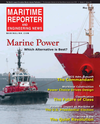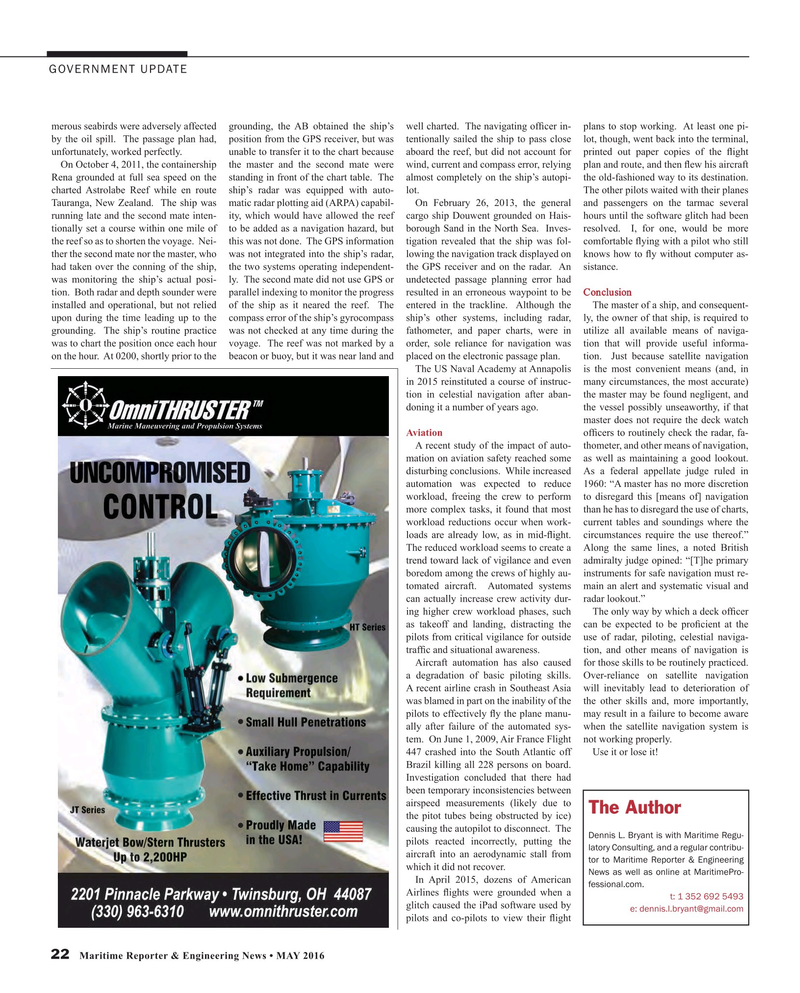
Page 22: of Maritime Reporter Magazine (May 2016)
The Marine Propulsion Edition
Read this page in Pdf, Flash or Html5 edition of May 2016 Maritime Reporter Magazine
GOVERNMENT UPDATE merous seabirds were adversely affected grounding, the AB obtained the ship’s well charted. The navigating of? cer in- plans to stop working. At least one pi- by the oil spill. The passage plan had, position from the GPS receiver, but was tentionally sailed the ship to pass close lot, though, went back into the terminal, unfortunately, worked perfectly. unable to transfer it to the chart because aboard the reef, but did not account for printed out paper copies of the ? ight
On October 4, 2011, the containership the master and the second mate were wind, current and compass error, relying plan and route, and then ? ew his aircraft
Rena grounded at full sea speed on the standing in front of the chart table. The almost completely on the ship’s autopi- the old-fashioned way to its destination. charted Astrolabe Reef while en route ship’s radar was equipped with auto- lot. The other pilots waited with their planes
Tauranga, New Zealand. The ship was matic radar plotting aid (ARPA) capabil- On February 26, 2013, the general and passengers on the tarmac several running late and the second mate inten- ity, which would have allowed the reef cargo ship Douwent grounded on Hais- hours until the software glitch had been tionally set a course within one mile of to be added as a navigation hazard, but borough Sand in the North Sea. Inves- resolved. I, for one, would be more the reef so as to shorten the voyage. Nei- this was not done. The GPS information tigation revealed that the ship was fol- comfortable ? ying with a pilot who still ther the second mate nor the master, who was not integrated into the ship’s radar, lowing the navigation track displayed on knows how to ? y without computer as- had taken over the conning of the ship, the two systems operating independent- the GPS receiver and on the radar. An sistance.
was monitoring the ship’s actual posi- ly. The second mate did not use GPS or undetected passage planning error had tion. Both radar and depth sounder were parallel indexing to monitor the progress resulted in an erroneous waypoint to be Conclusion installed and operational, but not relied of the ship as it neared the reef. The entered in the trackline. Although the The master of a ship, and consequent- upon during the time leading up to the compass error of the ship’s gyrocompass ship’s other systems, including radar, ly, the owner of that ship, is required to grounding. The ship’s routine practice was not checked at any time during the fathometer, and paper charts, were in utilize all available means of naviga- was to chart the position once each hour voyage. The reef was not marked by a order, sole reliance for navigation was tion that will provide useful informa- on the hour. At 0200, shortly prior to the beacon or buoy, but it was near land and placed on the electronic passage plan. tion. Just because satellite navigation
The US Naval Academy at Annapolis is the most convenient means (and, in in 2015 reinstituted a course of instruc- many circumstances, the most accurate) tion in celestial navigation after aban- the master may be found negligent, and doning it a number of years ago. the vessel possibly unseaworthy, if that master does not require the deck watch
Aviation of? cers to routinely check the radar, fa-
A recent study of the impact of auto- thometer, and other means of navigation, mation on aviation safety reached some as well as maintaining a good lookout. disturbing conclusions. While increased As a federal appellate judge ruled in automation was expected to reduce 1960: “A master has no more discretion workload, freeing the crew to perform to disregard this [means of] navigation more complex tasks, it found that most than he has to disregard the use of charts, workload reductions occur when work- current tables and soundings where the loads are already low, as in mid-? ight. circumstances require the use thereof.”
The reduced workload seems to create a Along the same lines, a noted British trend toward lack of vigilance and even admiralty judge opined: “[T]he primary boredom among the crews of highly au- instruments for safe navigation must re- tomated aircraft. Automated systems main an alert and systematic visual and can actually increase crew activity dur- radar lookout.” ing higher crew workload phases, such The only way by which a deck of? cer as takeoff and landing, distracting the can be expected to be pro? cient at the pilots from critical vigilance for outside use of radar, piloting, celestial naviga- traf? c and situational awareness. tion, and other means of navigation is
Aircraft automation has also caused for those skills to be routinely practiced. a degradation of basic piloting skills. Over-reliance on satellite navigation
A recent airline crash in Southeast Asia will inevitably lead to deterioration of was blamed in part on the inability of the the other skills and, more importantly, pilots to effectively ? y the plane manu- may result in a failure to become aware ally after failure of the automated sys- when the satellite navigation system is tem. On June 1, 2009, Air France Flight not working properly.
447 crashed into the South Atlantic off Use it or lose it!
Brazil killing all 228 persons on board.
Investigation concluded that there had been temporary inconsistencies between airspeed measurements (likely due to
The Author the pitot tubes being obstructed by ice) causing the autopilot to disconnect. The
Dennis L. Bryant is with Maritime Regu- pilots reacted incorrectly, putting the latory Consulting, and a regular contribu- aircraft into an aerodynamic stall from tor to Maritime Reporter & Engineering which it did not recover.
News as well as online at MaritimePro-
In April 2015, dozens of American fessional.com.
Airlines ? ights were grounded when a t: 1 352 692 5493 glitch caused the iPad software used by e: [email protected] pilots and co-pilots to view their ? ight 22 Maritime Reporter & Engineering News • MAY 2016
MR #5 (18-25).indd 22 4/29/2016 3:52:51 PM

 21
21

 23
23
